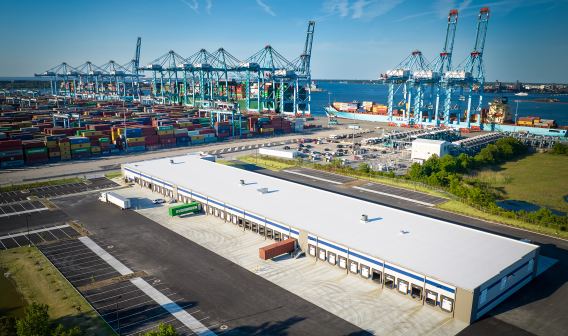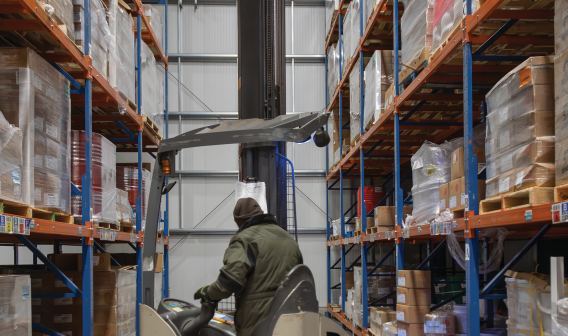The Quest for Supply Chain Balance
Through disruptive events, companies look to
strengthen supply chains while remaining cost-effective
Early in the morning of March 27, a container ship about as tall as the Eiffel Tower left the Port of Baltimore going approximately 9 mph. The ship, named the Dali, was fully loaded with cargo and weighed nearly 100,000 tons. Shortly after leaving the port, it lost power and collided with the Francis Scott Key Bridge. Six workers on the bridge fell to their deaths. The Baltimore icon, a 1970s engineering marvel, folded like wet cardboard, and one of the largest ports on the East Coast shut down instantly.
The accident highlighted the fragile nature of global supply chains, which are still recovering from the COVID-19 pandemic. But it also revealed how supply chain resilience can provide the flexibility manufacturers and shippers need when faced with ongoing disruption.
One node of the vast global web of supply chain infrastructure was ready to step in and support Baltimore through this crisis: The Port of Virginia.
Resiliency vs. Efficiency
The Port of Virginia is the sixth-largest port in the United States by container volume. It’s also the most efficient large port in North America, as ranked by the World Bank and S&P Global Market Intelligence. The morning of the Key Bridge collapse, Stephen Edwards, CEO of The Port of Virginia, immediately notified his team to expect additional ships diverted from Baltimore.
“I didn’t get a call because it wasn’t our port,” Edwards said. “But when I woke up, there were plenty of texts. I knew straight away it was a major event.”
According to Gary La Point, professor of supply chain practice at the Whitman School of Management at Syracuse University, ensuring supply chain resilience requires balancing efficiency with redundancy in manufacturing and transportation. “One of the big problems with creating a resilient supply chain is that it’s not necessarily an efficient supply chain,” La Point said. In other words, resilience comes at a cost.
Until the COVID-19 pandemic, companies optimized for efficiency over resiliency. “The pandemic woke everybody up because so many were caught completely off guard, and their supply chains suffered,” La Point said. “They had offshored and outsourced many of their [products] to Asia, particularly China.”
James Brucken, a Deloitte Consulting LLP specialist executive who advises government clients on supply chain issues, says increasing complexity has also contributed to supply chain fragility. “Globalization of supply chains over the years has increased risk. More cross-border activity involves more partners in countries, cities, and infrastructures across the world,” he said.
Now, companies are scrambling to change how they manage supply chains. La Point and Brucken say newly available data and advanced analytics can help.
Disruption as a Constant
According to Edwards, shippers deal with constant disruption.
“As you run through a year, you’re going to have a nor’easter. You’re going to have weather on the Atlantic. You’re going to have ship delays due to hurricane patterns in the summer,” he said. “Judging by looking out my window right now, we’ll probably have to stop operations at some point tonight due to high winds. These things happen in the normal course of business.”
Changes in how consumers purchase goods also play a role in supply chain disruption, like the shift to e-commerce during the COVID-19 pandemic.
E-commerce emphasizes last-mile shipments of small numbers of products to individual consumers instead of shipping pallets to retailers. This complicates logistics networks and puts downward pressure on revenue. Despite some retailers’ claims to the contrary, “Smaller, more frequent shipments are more expensive,” La Point said. “There’s no free shipping.”
Therein lies one of the challenges of building more resilient supply chains. Greater resilience means more sources of goods and more shipping methods acting as backups. But such redundancy increases costs, and that became abundantly clear during the pandemic.
An Unpredictable Environment
The pandemic exacerbated a persistent supply chain problem. “When you’re in the supply chain, you either have too much product or not enough product,” Brucken said. “It’s one or the other.”
During the pandemic, consumer demand radically changed when people stayed home in large numbers. “Spending shifted off of services, vacations, and leisure to hard goods delivered directly to homes,” Brucken said.
The change compounded an existing situation as goods flowed into the country and couldn’t move. “Containers were out of balance to begin with because we import far more than we export,” La Point said. “We had hundreds of ships parked off the coast, waiting to be unloaded, because we didn’t have any place to put anything. It took years to get rid of all the stuff in the warehouses.”
And the impact of this, according to Brucken, “is still an ongoing oscillation or bull-whip effect today.”
Complicating matters even further during the pandemic, a large container ship ran aground and blocked the Suez Canal for nearly a week, costing the global economy billions of dollars a day in trade. It turned out to be a preview of things to come.
In late 2023, a drought cut the Panama Canal’s capacity from 38 container ships daily to 24. Experts blame normal weather fluctuations, along with an overall warming trend.
Climate Disruptions
According to the latest U.S. National Climate Assessment, “Climate adaptation and emissions mitigation will require major transformations of supply chain transportation infrastructure and technologies.” The report cited drought, extreme heat, flooding, and more severe weather events.
Given the lingering supply chain headaches of the pandemic and ongoing global disruptions, “Just about every company now has made risk management a priority,” La Point said. “Virtually all have reassessed their supply chain strategies to reduce their risk of disrupting their continuity of supply.”
Companies are also assessing their contribution to global greenhouse gas emissions. Ed Elkins, executive vice president and chief marketing officer at Norfolk Southern Corporation, said rail transport, which is more efficient than other overland shipping modes, can aid companies in meeting their emissions goals.
“Railroads are an essential part of a low-carbon supply chain,” he said. “Our locomotives can haul one ton of freight over 470 miles on a single gallon of fuel.”
Rail transport, as part of a multimodal transport strategy incorporating maritime, road, and air, serves as a method of balancing competing shipping and inventory considerations. Over-reliance on air freight, while efficient, can drive up costs. The ability to flex between different modes of transport helps companies navigate delays and maintain a seamless flow of products.
Virginia’s port facilities enable companies to take advantage of multimodal capabilities. All of the port’s terminals rely on rail access and proximity to major highways to move goods on to their destinations, while the Richmond Marine Terminal’s James River barge service offers a maritime alternative to the port’s terminals in the Norfolk Harbor. Virginia’s mix of public and private investment, including privately held, interstate-adjacent freight processing operations, positions the Commonwealth as a complete gateway through which companies can reach suppliers and customers across the country and the world.
Sufficient and Resilient
Shorter supply chains are more resilient supply chains. La Point cites tool manufacturer Snap-on Incorporated as an example of a company that weathered the pandemic well because of short supply chains made possible by manufacturing goods near consumers. “For example, what they make in China stays in China,” he said. “It doesn’t come back to the United States.”
According to La Point, artificial intelligence (AI) is contributing to more accurate supply chain forecasts.
“In the next couple of years, you’re going to see a dramatic change in the ability of artificial intelligence to be used in supply chain decision-making,” he said. “How should things be routed? Where should we locate our distribution centers? Where do we locate manufacturing operations?”
AI can help supply chain managers with daily operations to prevent delivery delays like unplanned downtime. For example, Norfolk Southern is rolling out AI for automated rail car inspection. Trackside cameras capture hundreds of images per car as trains roll by. “Identified issues are promptly flagged and reviewed by experts at our Network Operations Center, ensuring proactive maintenance and immediate handling of any critical defects,” Elkins said.
Ready for What's Next
The operating team at The Port of Virginia reacted quickly to the Key Bridge collapse. Crews were unloading cargo originally bound for Baltimore by that evening, according to Edwards.
The supply chain effects of the Key Bridge collapse were temporary. The shipping channel was cleared within a few months of the accident. But other potential hazards will persist, from typical weather-related delays to the longer-term effects of climate change and global conflict. Supply chain managers and port operators will have to continue to adjust.
Virginia’s port facilities stand ready to serve as a partner to shippers, utilizing road, rail, and maritime options to move goods on to the next step in their supply chain journey. The port is investing $1.4 billion to expand its capabilities and efficiency and advance technology throughout the operation. This investment, Edwards said, positions The Port of Virginia for long-term growth and almost any eventuality.
“We found that we can flex capacity quite quickly, and that allows for these disruptive events,” he said. “We’re determined to stay ahead of the curve.”




